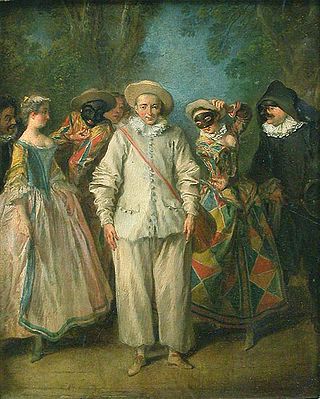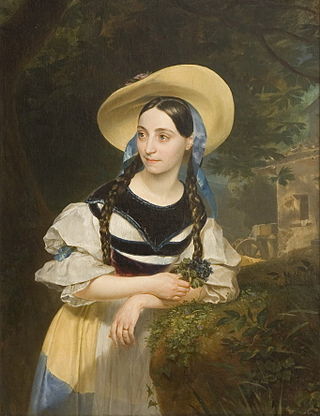
Luigi Lablache was an Italian opera singer of French and Irish ancestry. He was most noted for his comic performances, possessing a powerful and agile bass voice, a wide range, and adroit acting skills: Leporello in Don Giovanni was one of his signature roles.

La gazza ladra is a melodramma or opera semiseria in two acts by Gioachino Rossini, with a libretto by Giovanni Gherardini based on La pie voleuse by Théodore Baudouin d'Aubigny and Louis-Charles Caigniez. The Thieving Magpie is best known for the overture, which is musically notable for its use of snare drums. This memorable section in Rossini's overture evokes the image of the opera's main subject: a devilishly clever, thieving magpie.

Gianluigi Gelmetti OMRI, was an Italian-Monégasque conductor and composer.
The Aria di sorbetto, or "sorbet aria", was a convention of Italian opera in the early nineteenth century. It comprised a short solo performed by a secondary character in the opera.

Comédie-Italienne or Théâtre-Italien are French names which have been used to refer to Italian-language theatre and opera when performed in France.
Alessandro Corbelli is an Italian baritone opera singer. One of the world's pre-eminent singers specializing in Mozart and Rossini, Corbelli has sung in many major opera houses around the world and won admiration for his elegant singing style and sharp characterizations, especially in comic roles.

Filippo Galli was an Italian opera singer who began his career as a tenor in 1801 but went on to become one of the most acclaimed basses of the bel canto era, with a voice known for its wide range, extreme agility, and expressivity, and a remarkable gift for acting.

Sesto Bruscantini was an Italian baritone, one of the greatest buffo singers of the post-war era, especially renowned in Mozart and Rossini.

Fanny Tacchinardi Persiani was an Italian soprano particularly associated with bel canto composers, such as Rossini, Donizetti, Bellini, and early Verdi. Her 'golden' period in Paris and London was between 1837 and 1848.

Lucia Valentini Terrani was an Italian coloratura mezzo-soprano, particularly associated with Rossini roles.

Domenico Cosselli was an Italian operatic bass-baritone, particularly associated with Rossini operas.

Giuseppina Ronzi de Begnis was an Italian soprano opera singer famous for the roles written for her by the prominent composers of the 1820s and 1830s. Her father, Gaspare, was a prominent ballet dancer and choreographer, and her mother, Antonia, was a ballerina. Her brothers Stanislao and Pollione were opera singers. As a singer, she made her debut in Naples at the Teatro dei Fiorentini in 1814 in Giovanni Cordella's L'Avaro, followed by important engagements in Bologna in 1816, also appearing in Genoa, Florence; in 1817 as Giulia La Vestale, and in Bergamo. She married Italian bass Giuseppe de Begnis (1793–1849) when she was only 16. The marriage lasted only a few years and the two separated in 1825.

Nino Machaidze is a Georgian operatic soprano. She performs in 19th-century Romantic repertoire, primarily in operas by Rossini and Verdi as well as French operas. Beginning her career at La Scala, she gained international attention after being cast as Juliette in Gounod's Roméo et Juliette at the 2008 Salzburg Festival, after which she earned the nickname "Angelina Jolie of Opera" from the Austrian press.
John Ebers was an English operatic manager, notable for his promotion of Italian opera in London in the 1820s.
Mark Milhofer is an English operatic tenor, who has performed at major international opera houses, beginning his career in Italy. Besides the standard repertoire, the singer has appeared in historically informed performances such as Monterverdi's L'incoronazione di Poppea, in 20th-century operas by Benjamin Britten and Gian Carlo Menotti, and in premieres of new operas.
Jolanta Omilian, real name: Jolanta Omiljanowicz-Quattrini, is a Polish opera singer, singing mainly belcanto and dramatic soprano parts.

The Rossini Bicentennial Birthday Gala is a live album of operatic and sacred music by Gioachino Rossini, performed by Rockwell Blake, Craig Estep, Maria Fortuna, Thomas Hampson, George Hogan, Marilyn Horne, Kathleen Kuhlmann, Mimi Lerner, Chris Merritt, Jan Opalach, Samuel Ramey, Henry Runey, Frederica von Stade, Deborah Voigt, the Concert Chorale of New York and the Orchestra of St. Luke's under the direction of Sir Roger Norrington. It was released in 1993 as a 119-minute video album and in 1994 as a 78-minute CD.
Michele Pertusi is an Italian opera singer (bass) born in Parma on January 12, 1965.
Savino Monelli was an Italian tenor prominent in the opera houses of Italy from 1806 until 1830. Amongst the numerous roles he created in world premieres were Giannetto in Rossini's La gazza ladra, Enrico in Donizetti's L'ajo nell'imbarazzo and Nadir in Pacini's La schiava in Bagdad. He was born in Fermo where he initially studied music. After leaving the stage, he retired to Fermo and died there five years later at the age of 52.

Luigi Pacini was an Italian opera singer who appeared on the principal stages of his native country as well as in Spain and Austria in a career that spanned over 30 years. He began his career as a tenor but in 1805 started singing bass roles and rose to prominence in that repertoire. Amongst the numerous roles he created in world premieres were Geronio in Rossini's Il turco in Italia and Parmenione in his L'occasione fa il ladro. Pacini was born in the Province of Pistoia and died in Viareggio where in his later years he taught singing at the conservatory founded by his son, Giovanni Pacini.















